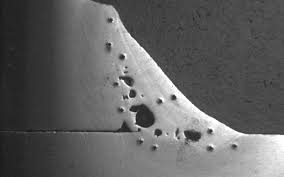What is Porosity in Welding: Understanding Its Causes and Enhancing Your Skills
Wiki Article
Untangling the Enigma of Porosity in Welding: Tips for Reducing Issues and Making The Most Of Quality
In the complex world of welding, porosity remains a persistent difficulty that can considerably affect the top quality and stability of welded joints. Comprehending the aspects that add to porosity development is vital in the search of remarkable welds. By unraveling the mystery of porosity and applying effective methods for flaw minimization, welders can elevate the standards of their job to attain premium top quality results. As we look into the depths of porosity in welding, discovering the keys to its prevention and control will certainly be paramount for professionals looking for to grasp the art of top quality weldments.Comprehending Porosity in Welding
Porosity in welding, a common issue run into by welders, describes the existence of gas pockets or gaps in the bonded material, which can endanger the honesty and quality of the weld. These gas pockets are normally caught throughout the welding process as a result of numerous elements such as incorrect protecting gas, infected base products, or wrong welding criteria. The formation of porosity can compromise the weld, making it vulnerable to breaking and rust, eventually causing structural failures.Recognizing the source of porosity is essential for welders to properly prevent its event. By acknowledging the importance of maintaining correct gas shielding, making sure the cleanliness of base products, and maximizing welding setups, welders can substantially lower the probability of porosity development. In addition, making use of strategies like pre-heating the base product, using correct welding techniques, and performing comprehensive evaluations post-welding can additionally help in reducing porosity flaws. Generally, an extensive understanding of porosity in welding is necessary for welders to generate high-quality and durable welds.

Common Reasons of Porosity
When inspecting welding processes for possible quality issues, understanding the typical root causes of porosity is vital for preserving weld honesty and avoiding architectural failures. Porosity, characterized by the presence of tooth cavities or voids in the weld metal, can dramatically jeopardize the mechanical residential or commercial properties of a bonded joint. One common reason for porosity is improper shielding gas protection. Insufficient securing gas flow rates or inappropriate gas combinations can result in climatic contamination, resulting in porosity development.
Another prevalent source of porosity is the presence of moisture and pollutants on the surface of the base steel or filler product. When welding materials are not appropriately cleansed or are exposed to high degrees of humidity, the evaporation of these pollutants throughout welding can create gaps within the weld bead. Additionally, welding at inappropriate specifications, such as exceedingly high travel speeds or currents, can produce too much turbulence in the weld swimming pool, capturing gases and causing porosity. By addressing these common reasons through appropriate gas shielding, material prep work, and adherence to optimum welding criteria, welders can reduce porosity and boost the high quality of their welds.
Techniques for Porosity Avoidance
Applying efficient preventive steps is crucial in lessening the occurrence of porosity in welding processes. One method for porosity avoidance is ensuring appropriate cleaning of the base metal prior to welding. Impurities such as oil, grease, corrosion, and paint can bring about porosity, so extensive cleaning utilizing proper solvents or mechanical approaches is necessary.
Using top quality filler materials and securing i was reading this gases that are suitable for the base steel and welding process can considerably decrease the danger of porosity. Additionally, keeping proper welding specifications, such as voltage, current, travel rate, and gas flow rate, is important for porosity avoidance.
Additionally, using proper welding methods, such as preserving a constant travel rate, electrode angle, and arc size, can assist protect against porosity (What is Porosity). Ample training of welders to guarantee they follow finest methods and quality assurance procedures is likewise crucial in lessening porosity flaws in welding

Best Practices for Top Quality Welds
One secret technique is preserving correct sanitation in the welding area. Thoroughly cleansing the work surface and bordering location prior to welding can aid alleviate these concerns.One more finest practice is to very carefully select the ideal welding specifications for the specific products being joined. Correct parameter choice makes sure optimal weld penetration, fusion, and total top quality. Making use of premium welding consumables, such as electrodes and filler metals, can significantly impact the final weld high quality.
Value of Porosity Control
Porosity control plays an important duty in making certain the integrity and quality of welding joints. Porosity, characterized by the existence of tooth cavities or gaps within the weld steel, can significantly endanger the mechanical buildings and structural honesty of the weld. Excessive porosity weakens the weld, making it much more prone to cracking, corrosion, and general failing under operational tons.Effective porosity control is essential for keeping the preferred mechanical properties, such as toughness, ductility, and sturdiness, of the bonded joint. What is Porosity. By decreasing porosity, welders can boost the general top quality and reliability of the weld, ensuring that it fulfills the performance demands of the desired application
Moreover, porosity control important site is important for attaining the wanted aesthetic appearance of the weld. Excessive porosity not only damages the weld yet likewise takes away from its visual charm, which can be important in sectors where aesthetics are essential. Proper porosity control strategies, such as utilizing the appropriate protecting gas, regulating the welding parameters, and making sure correct tidiness of the base materials, are important for producing high-quality welds with very little issues.

Verdict
In verdict, porosity in welding is a typical defect that can compromise the quality of the weld. By recognizing the reasons check over here for porosity and carrying out appropriate prevention methods, welders can minimize problems and accomplish higher top quality welds. It is vital to regulate porosity in welding to make certain the honesty and strength of the end product. Implementing ideal methods for porosity control is vital for achieving optimum welding outcomes.Report this wiki page